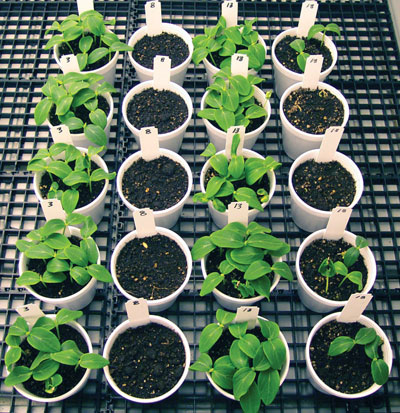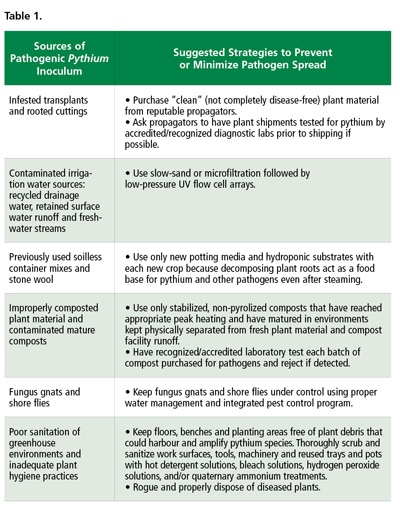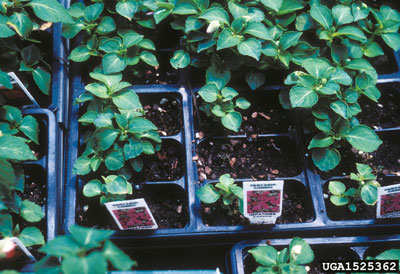
Features
Crop Protection
Inputs
Managing pythium
December 19, 2012 By Matthew Krause and Randy Martin
Pythium damping-off and pythium root and crown rot diseases are among the most economically important plant diseases that affect horticultural crop production. Nearly every cultivated crop can suffer from soilborne diseases caused by pythium species. Yet, with good basic knowledge, a proactive approach, and proper application of some simple concepts, greenhouse growers can safely, effectively and economically manage pythium diseases.
 |
|
| Fig. 1 – pythium damping-off of cucumber plants.
|
Most species of pythium are either plant pathogens or simple decomposers in soil and water environments. In the absence of germinating seeds or host plant root tips, plant-pathogenic pythium species will survive in environments containing fresh or slightly decomposed organic matter, feeding on sugars, starches and cellulose. These pathogenic species can biochemically sense the presence of susceptible host tissue and very quickly respond and attack. These qualities make them especially nimble and aggressive pathogens.
The most widespread plant-pathogenic species in greenhouse horticulture are Pythium aphanidermatum, P. irregulare, and P. ultimum. P. aphanidermatum has mostly been associated with greenhouse production of poinsettia, whileP. ultimum and irregular are predominant among greenhouse vegetable and floricultural crops.
Fig. 1 is an illustration of pythium damping-off of cucumber in two different potting mixes. The first two rows (L-R) are cucumber seedlings grown in compost-amended potting mix and the last two rows are cucumber seedlings grown in a standard peat-based potting mix. Potting mixes in rows 2 and 4 were infested with the pathogen Pythium ultimum, which shows severe Pythium damping-off. Potting mixes in rows 1 and 3 were not infested with the pathogen and show healthy cucumber seedling germination.
Plant-pathogenic pythium species can cause damping-off of seedlings as well as root and crown rots of young and mature plants.
Damping-off symptoms are simply characterized by failed germination of seed due to seed infection (pre-emergence damping-off) or death of germinated seedlings caused by infection and rapid death of emerged tissue at the soil line (post-emergence damping-off).
Root rots typically occur as a result of initial infection of root tips or damaged roots by pythium, which progresses along older root tissue as disease advances.
Crown rots occur at the soil line as a result of advanced root rots or stem infections characterized by lesions or discoloration at the crown.
As with any plant disease, it is best to have a university diagnostic clinic or a reputable independent diagnostic laboratory determine the actual cause of disease so that the appropriate methods for treatment and prevention are identified. Misdiagnoses of plant diseases frequently result in increased cost of production and decreased yield.
INTEGRATED MANAGEMENT OF DISEASES CAUSED BY PYTHIUM SPP.
■ Understanding how plant-pathogenic pythium species spread and the conditions that favour disease development can help every grower build a better pythium disease management program.
Table 1 identifies known sources of pathogenic pythium and strategies that can be used to mitigate or prevent the spread of inoculum.
 |
Though pathogenic pythium species can attack both healthy and stressed plants, there are certain conditions that favour pythium disease development. Such conditions include:
- Poor gas exchange around roots.
- Constantly waterlogged potting media.
- High soluble salts status in pots and recycled irrigation ponds.
- Environmental extremes.
- Improper use of crop protection products.
- Potting media containing unstable organic matter.
Prevention is the first and most economical line of defence for effectively managing pythium diseases. Special attention paid to developing and implementing effective cultural disease prevention practices can radically reduce disease risk and minimize disease management costs later.
The following strategies can be used to prevent or mitigate circumstances that promote development of pythium diseases in greenhouse plant production:
- Ensure that potting media are well drained and not constantly saturated (wetter is not better).
- Avoid constant high salinity in growing media.
- Refrain from using fresh or unstabilized organic matter in potting media or in hydroponic culture, especially molasses, sugars and cellulosic substances. Such materials typically cause increases in pathogen levels and may suppress activity of otherwise effective biocontrol agents.
- Eliminate pyrolized container mix components such as bark ash and “biochar” because these materials immobilize plant nutrients and fungicides as well as reduce porosity over time.
- Carefully follow label instructions for proper use of fungicides and surface disinfectants to prevent phytotoxicity.
- Manage diseases caused by other pathogens.
- Protect plants from environmental injury brought on by excessive heat, cold and dry cycles.
Use of ebb-and-flood irrigation puts crops at high risk of developing soilborne pythium diseases. High disease pressures induced by ebb-and-flood frequently require intense use of chemical fungicides. This can increase stress to the plant, add to production costs and aid in the development of fungicide-resistant pythium strains.
 |
|
| Pythium on impatiens
|
Growers should consider using other irrigation practices such as drip and overhead irrigation to reduce the risk of disease and the development of fungicide-resistant pythium populations.
Even if you have the best cultural practices in place, you can expect that all plant diseases, including those caused by pythium, are still possible.
In natural soils, diseases are kept in check by a diversity of competing or antagonistic micro-organisms. As horticultural technology has advanced over time to give us greater production efficiencies and more esthetic plant varieties, plant-pathogenic pythium species (and other pathogens) have evolved into greater and greater threats.
Many of our modern horticultural production practices actually favour the growth, development and spread of pathogenic pythium species.
These can include new varieties that are developed for showy characteristics only, ebb-and-flood irrigation, intense fertility programs followed by growth regulators, and hydroponic systems that lack partitioning (e.g., pool-based floating tray systems).
The availability of effective synthetic fungicides has allowed growers to produce healthy-looking greenhouse and field crops. Typically, when a grower observes pythium disease symptoms, the first reaction is to reach for the chemical remedy. However, intensive, widespread and programmed use of these chemicals has resulted in the development of resistant pythium populations.
Along with cultural strategies, using a preventive protection approach with registered biocontrol products can be highly effective. Nearly all registered biocontrol agents that are effective against
pythium species work preventively rather than curatively. They generally colonize growing media, soils and even plant roots to prevent establishment, proliferation and activity of pythium.
Among the mechanisms that biocontrol agents use to control pythium diseases are production of antagonistic metabolites, competition for space and nutrients, and actually feeding on pythium propagules. A few registered biopesticides actually control pythium diseases using multiple modes of action.
Biocontrol agents work best when pathogen pressure is low to moderate. Because their activities against pathogens are biological by nature, it is possible they will not be effective when overwhelmed by high pathogen levels.
Such high levels of pythium are rare early in a crop cycle if proper sanitation and cultural practices are followed. Furthermore, using biological fungicides as part of a management program will mitigate the development of chemical-resistant pathogens.
In addition, biocontrol agents are generally not effective once plants have been infected by pythium and thus should not be considered curative control treatments.
 |
|
| Author Randy Martin |
|
 |
|
| Matthew Krause, of BioWorks
|
Use of preventive cultural and biological protection practices can be considered effective and economical most of the time. However, there are times when unpredictable factors or unavoidable disease pressures arise that demand the use of chemicals.
The range of effective registered chemical fungicides currently available to growers for managing pythium damping-off and crown and root rot diseases is narrow. Several of these fungicides are quite effective against pythium diseases, though most involve single modes of action against the pathogen. However, these single modes of action can be defeated quickly by the development of resistance to them in pythium populations promoted by widespread and intense use of them.
The narrow list of available fungicides combined with the potential for rapid development of fungicide resistance and public concern for human and environmental health has made integrated disease management very important for growers to practise.
Hence, it is vital for growers to learn how to manage these diseases using multiple strategies. Knowing how pythium species can enter and persist in your facility is the first step to successful management. Consider all valid strategies for culturally and biologically preventing development of soilborne pythium diseases so that chemical approaches can be reserved for when they are truly necessary.
Matthew Krause, PhD, and Randy Martin, PhD, are product development managers in Plant Disease Management and Insect and Pest Management, respectively, at BioWorks.
Print this page